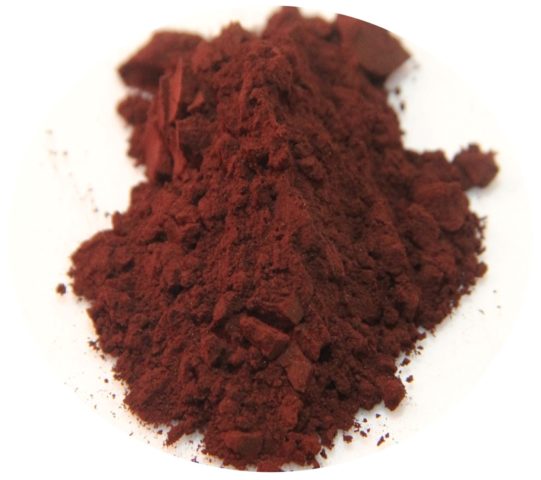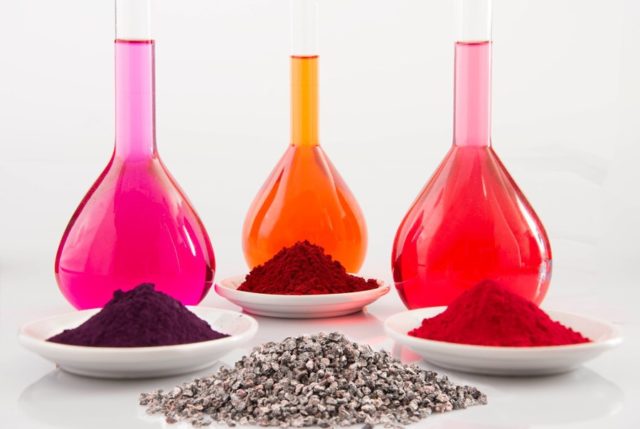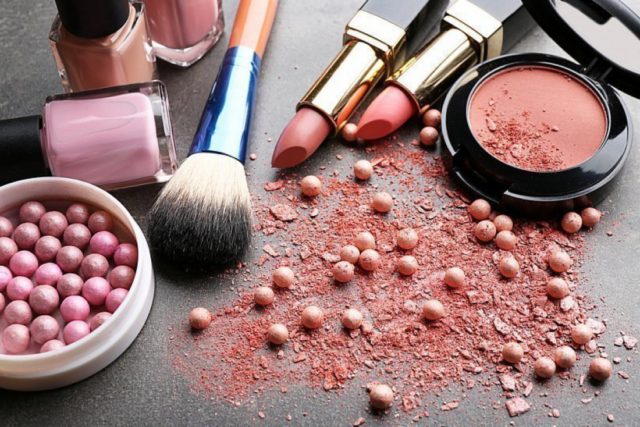Content
E122 dye is a synthetic substance that has no natural analogues. It is obtained in laboratory conditions using complex chemical reactions. It is an officially approved food additive in Russia and European countries, and is actively used in the manufacture of many food products. The main property of E122 is the ability to color.
What kind of additive is E122

According to GOST, the additive can be called azorubin, carmoisine, food red 3 (in the cosmetic industry), acid red (in pharmacology). The name E122 is used in the international classification of food additives.
Physical and chemical characteristics of E122 dye:
- The color of the substance is red, brick, maroon.
- Let's well dissolve in water in different proportions. In this case, it forms a solution of a red tint.
- Produced in the form of powder or small granules.
- Resistant to light and high temperatures (up to 160 ° C).
- Moderate alkali resistance is observed.
- There is no smell and taste.
In the food industry it is used to impart an attractive appetizing shade to food products, to restore the color of the product after heat treatment. Paints products in various colors - from pale pink to deep red. By mixing E122 with some other dyes, violet, lilac, green, orange and brown colors can be obtained.
What food coloring E122 is made of
E122 dye is a substance of completely synthetic origin. It contains nitrogenous compounds. Carmoisine belongs to the dyes from the naphthalene group. The substance does not occur in nature, unlike cochineal red (E124), which is extracted from natural ingredients. E122 is obtained in laboratories by distillation of coal tar. The substance was first discovered at the beginning of the last century, during the rapid development of the chemical industry. They got it as a result of transformation of coal tar.
Packaging, transportation and storage of carmoisine is controlled by the National Standard of Russia. Transportation is carried out in corrugated cardboard boxes or fabric, paper, tightly sealed bags. Each of them must have a certain marking.

India and Germany are among the world's largest producers. In the Russian Federation, the leading position is occupied by manufacturing companies from Moscow and St. Petersburg - JSC Eco Resource, LLC Teresa-Inter.
The benefits and harms of E122 dye
There is no data on the beneficial qualities of the dye for the human body. The benefits are obvious only for food manufacturers where this food additive is used, since it gives an appetizing color to the product, extends the shelf life of the product, and has an affordable price compared to natural dyes.
E122 has a harmful effect on the human body. The most possible negative reactions from the body:
- asthma attacks, especially in asthmatics;
- allergic manifestations;
- profuse skin rashes, severe itching;
- rhinitis;
- lacrimation;
- decreased concentration of attention in children, hyperactivity, aggression;
- upset of the gastrointestinal tract;
- violation of the cardiovascular system.
In this regard, the World Health Organization has established the permissible daily intake of E122 - 4 mg per 1 kg of body weight.
Dangerous or not E122 dye for the body
Officially, karmuazin is approved for use in Russia and a number of other countries. Banned dye in Japan, Austria, Sweden, UK, Canada and Norway. As for the United States, E122 was banned from using only in the production of medicines and cosmetics. In these countries, the dye azorubin E122 is prohibited, its harm has been proven, experts considered it a carcinogen, since the substance contains heavy resins and provokes the development of cancer.

It is worth noting that numerous studies have not provided guarantees regarding the safety of the dietary supplement. Independent research centers identify the E122 dye as suspicious and class it as hazard class 3. In this case, it is definitely not worth using it for children, pregnant and lactating women, people with chronic diseases of the respiratory, digestive and circulatory system, allergy sufferers.
The danger of the E122 dye lies in the fact that all azo dyes have the ability to be broken down in the body into amines - organic compounds that are derivatives of ammonia. After the amines enter the bloodstream, a person develops shortness of breath, rapid heartbeat. In addition, they are very toxic, negatively affecting the liver and nervous system.
Where and why add the dye karmuazin E122
The dye is used in the food industry. It is used to add color to the product, to restore the desired shade after heat treatment, to enhance the natural color of the product.
Most commonly, dye is added to the following foods:
- meat products (sausages, minced meat, canned food);
- fish products (minced meat, caviar, smoked red fish);
- processed cheeses;
- pasta;
- sauces, seasonings, mustard;
- pastries, sweets, marmalade, decorative decorations for desserts;
- snacks;
- juices, carbonated drinks;
- canned fruits and vegetables;
- alcohol;
- jams, preserves, syrups;
- ice cream;
- yoghurts.

Carmoisine dye is widely used in the cosmetic industry to impart the desired color to the product. Most often it is used in the manufacture of decorative cosmetics - lipsticks, blush, shadows, as well as hair dyes, soaps, shower gels, toilet water and perfumes.
Conclusion
E122 dye is a food additive used to improve the natural color of the product. Large-scale studies regarding its effect on the human body have found harmful components that, with frequent use, adversely affect the health of children and adults. The dye is actively used in meat, fish, dairy products and even in children's juices. The E122 additive has been recognized as potentially hazardous to health.

